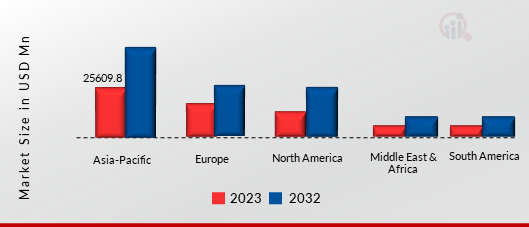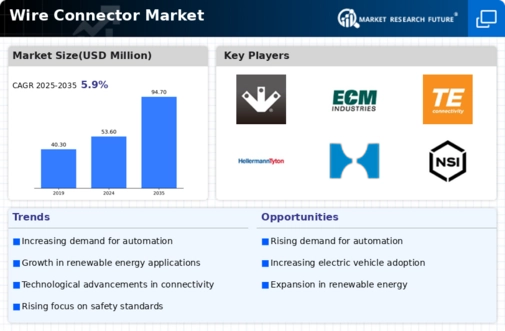By Region, the study provides market insights into North America, Europe, Asia-Pacific and Rest of the World. The wire connector market in North America is experiencing steady growth due to increasing demand across various industries, including construction, automotive, renewable energy, and electronics. North America, particularly the United States, is a mature market with a strong emphasis on safety standards, innovation, and regulatory compliance, which further drives the adoption of high-quality wire connectors. A real-life example can be seen in the automotive industry, where wire connectors are crucial for the growing electric vehicle (EV) market.
Companies like Tesla and General Motors rely on high-performance wire connectors for critical components such as battery management systems, charging stations, and motor systems. These connectors must meet stringent safety standards to ensure that high-voltage systems are secure and reliable.
The wire connector market in Europe is experiencing significant growth, driven by a combination of technological advancements, stringent safety regulations, and the region's increasing focus on sustainability and renewable energy. Europe is a leader in the adoption of energy-efficient systems, and this is fueling demand for reliable and high-performance wire connectors. A notable example can be seen in the renewable energy sector, particularly in solar energy projects. Europe has been rapidly expanding its use of solar power, and countries like Germany, France, and Spain have been at the forefront of this shift.
In these solar installations, connectors are critical to linking solar panels with inverters, batteries, and the grid. Waterproof and UV-resistant connectors are widely used in outdoor solar arrays to ensure that the electrical connections remain secure and operational in all weather conditions, especially in regions with high levels of sunlight or rain.
The wire connector market in the Asia Pacific region is expanding rapidly, driven by the region's booming industrialization, urbanization, and growing infrastructure investments. Asia Pacific, particularly countries like China, India, and Japan, is experiencing high demand for wire connectors across sectors like construction, automotive, renewable energy, and consumer electronics. A prime example of this growth can be seen in China’s renewable energy industry, which is one of the largest in the world. As China continues to invest heavily in solar power, wind energy, and smart grid systems, the need for reliable and durable wire connectors has surged.
In solar power projects, for example, connectors are used to link solar panels to inverters and storage systems. These waterproof, high-temperature-resistant connectors are critical in ensuring the longevity and performance of solar arrays, especially in harsh outdoor environments.
The wire connector market in the Middle East and Africa (MEA) region is experiencing notable growth, fueled by rapid infrastructure development, the expansion of renewable energy projects, and increased demand for reliable electrical solutions in both residential and industrial sectors. A key driver of this growth is the construction boom across countries like the United Arab Emirates (UAE), Saudi Arabia, and South Africa, where large-scale residential, commercial, and industrial projects require secure and efficient electrical wiring systems.
In cities like Dubai and Abu Dhabi, the demand for wire connectors is high due to ambitious infrastructure projects such as smart cities, high-rise buildings, and modern industrial facilities. These projects often rely on fire-resistant and waterproof wire connectors to ensure safety in harsh environments, particularly in high-rise buildings, where electrical systems need to be secure and capable of withstanding extreme temperatures and humidity.
The wire connector market in South America is growing steadily, driven by infrastructure development, the expansion of renewable energy projects, and increasing industrial activity across the region. Countries like Brazil, Argentina, and Chile are witnessing significant investments in both urban infrastructure and energy sectors, which is spurring demand for reliable electrical connections. A prime example can be seen in Brazil’s renewable energy sector, where the country is making substantial strides in solar power and wind energy projects.
Brazil is one of the largest producers of renewable energy in South America, and its solar and wind farms require robust wire connectors to ensure efficient and safe transmission of electricity. For instance, connectors used in these projects must be able to withstand outdoor conditions such as high humidity and extreme temperatures, which has led to the adoption of waterproof and UV-resistant connectors that can ensure longevity and reliability.
FIGURE 3: WIRE CONNECTOR MARKET VALUE BY REGION 2024 and 2035 (USD Million)

Source: Secondary Research, Primary Research, MRFR Database, and Analyst Review
Further, the countries considered in the scope of the Wire Connector Market are the US, Canada, Mexico, UK, Germany, France, Italy, Spain, Switzerland, Austria, Belgium, Denmark, Finland, Greece, Hungary, Italy, Luxembourg, Netherlands, Norway, Poland, Portugal, Slovakia, Sweden, Romania, Ireland, China, Japan, Singapore, Malaysia, Indonesia, Philippines, South Korea, Hong Kong, Macau, Singapore, Brunei, India, Australia & New Zealand, South Africa, Egypt, Nigeria, Saudi Arabia, Qatar, United Arab Emirates, Bahrain, Kuwait, and Oman, Brazil, Argentina, Chile, and others.








